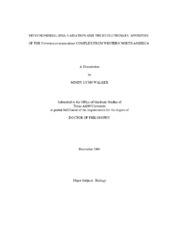| dc.contributor.advisor | Greenbaum, Ira F. | |
| dc.creator | Walker, Mindy Lynn | |
| dc.date.accessioned | 2006-04-12T16:04:37Z | |
| dc.date.available | 2006-04-12T16:04:37Z | |
| dc.date.created | 2005-12 | |
| dc.date.issued | 2006-04-12 | |
| dc.identifier.uri | https://hdl.handle.net/1969.1/3216 | |
| dc.description.abstract | Intraspecific phylogeography and the phylogenetic relationships of recently-diverged taxa are best assessed with the use of a genetic marker that coalesces rapidly and thus provides phylogenetically informative characters for closely-related taxa. Mitochondrial DNA (mtDNA) fits these criteria and was thereby ideal for analyzing genetic variation within and among the youngest taxonomic members of the Peromyscus maniculatus species group, P. sejugis (restricted to two islands in the Sea of Cortés), P. maniculatus (distributed throughout North and Central America) and P. keeni (a coastal species restricted to the Pacific Northwest of North America). The approach utilized in this research involved sequencing a 1439 base-pair (bp) region of mtDNA for a total of 581 specimens representing 45 different geographic localities from along the west coast of North America. The sequences obtained were used to assess the partitioning of genetic diversity within and among these taxa, address phylogenetic and taxonomic concerns about the western representatives of the P. maniculatus species group and discuss the post-Pleistocene biogeography of the west coast of North America. Analysis of mtDNA sequence variation, considered within the framework of a phylogenetic species concept, revealed the existence of two evolutionarily significant units of P. sejugis as well as a previously unrecognized sibling species nested within the Pacific coastal range of P. maniculatus. Moreover, analysis of intraspecific sequence divergence allowed for the identification of the ice-free refugium thought to harbor P. keeni throughout glaciation during the Pleistocene epoch. This work will establish the foundation for additional examination of cryptic genetic variation in different morphotypes of P. maniculatus and continue the precedent for recognizing P. maniculatus-group taxa that reflect true evolutionary entities. | en |
| dc.format.extent | 917569 bytes | en |
| dc.format.medium | electronic | en |
| dc.format.mimetype | application/pdf | |
| dc.language.iso | en_US | |
| dc.publisher | Texas A&M University | |
| dc.subject | Peromyscus maniculatus | en |
| dc.subject | Peromyscus keeni | en |
| dc.subject | Peromyscus sejugis | en |
| dc.subject | California | en |
| dc.subject | Baja | en |
| dc.subject | Hecate | en |
| dc.title | Mitochondrial-DNA variation and the evolutionary affinities of the Peromyscus maniculatus complex from western North America | en |
| dc.type | Book | en |
| dc.type | Thesis | en |
| thesis.degree.department | Biology | en |
| thesis.degree.discipline | Biology | en |
| thesis.degree.grantor | Texas A&M University | en |
| thesis.degree.name | Doctor of Philosophy | en |
| thesis.degree.level | Doctoral | en |
| dc.contributor.committeeMember | Bickham, John W. | |
| dc.contributor.committeeMember | Cognato, Anthony I. | |
| dc.contributor.committeeMember | Honeycutt, Rodney L. | |
| dc.type.genre | Electronic Dissertation | en |
| dc.type.material | text | en |
| dc.format.digitalOrigin | born digital | en |


